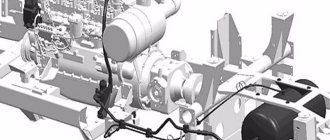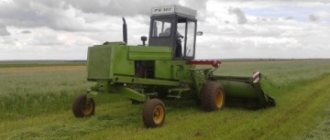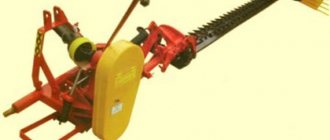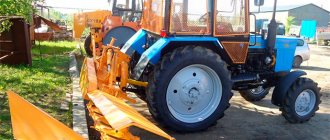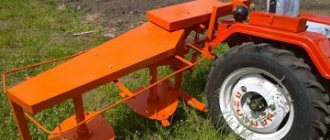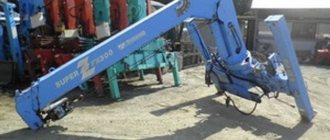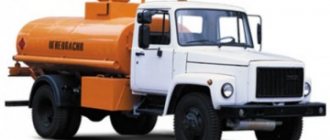In agriculture, mowing grass is not the least important task. For high-quality and efficient grass harvesting, a self-propelled mower-conditioner KPS 5G was created. This will be the subject of today's discussion.
The material will introduce its technical characteristics and user reviews. The article uses video materials. Potential buyers can find out the price of the KPS 5G model.
Mounted tedder rake: characteristics, price, photos, reviews, video.
Wheeled finger tedder rake GKP 5 here.
Technical parameters of the self-propelled mower-conditioner KPS 5G
In agriculture, mowing grass is not the least important task.
For high-quality and efficient grass harvesting, a self-propelled mower-conditioner KPS 5G was created. This will be the subject of today's discussion. The material will introduce its technical characteristics and user reviews. The article uses video materials. Potential buyers can find out the price of the KPS 5G model.
Mounted tedder rake: characteristics, price, photos, reviews, video.
Wheeled finger tedder rake GKP 5 here.
Self-propelled mower-conditioner KPS 5G characteristics
The KRS 5G model is equipped with a D-240 power unit. The power of the diesel engine is 58.8 kW. The header operates over a working width of 5 meters at a maximum speed of 10 km/h. Three gears using a hydraulic drive change the speed of movement:
- In first gear, speed indicators are increased to 6.56 km/h.
- On the second the indicators are 13 km/h.
- The car's performance in third gear is 20 km/h.
The self-propelled mower-conditioner KPS 5G with a video, which can be found at the end of the article, is equipped (if desired) with additional equipment that allows mowing grain crops and turning windrows.
Preparation for work and operation
Before starting work, you need to refuel the wheeled tractor and then check the oil level in the hydraulic system. It is recommended to check the tire pressure and adjust the wheel track depending on the type of work planned. At the installation, the braces are connected to the rods; the switching scheme depends on the modification of the cultivator. Bolts are installed at the connection points and tightened until they stop. The design of the agricultural machine provides points for installing the frame of the automatic coupling device.
The tractor is installed with its stern facing the cultivator, and then the coupling elements installed on the machines are connected. Hydraulic hoses are connected with locking couplings, ensuring the tightness of the joint. The design has adjusting nuts that allow you to adjust the length of the safety chains. After setting the working gap, the equipment is transported to the field, and a hydraulic cylinder is used to control the position of the frame.
Self-propelled mower-conditioner KPS 5G price per unit of equipment
There are not many offers for the sale of equipment.
Most enterprises offer to bring a mower-conditioner to order and deposit 100% of the cost into their account. The average price in Russia is 173,000.00 rubles. There are options for purchasing equipment that has served for a certain time. The price is naturally lower, in the range of 120,000.00 - 137,500.00 rubles. But the question of the quality of the product being sold remains open!
You can buy agricultural machinery on lease or on credit. However, the interest rates offered by banks only discourage potential buyers.
IRK 145 roll roughage chopper: technical specifications, reviews, videos, price.
Square baler PT 165M here.
Read the review of the PR-F-180 baler in this article.
Maintenance and repair
Before starting work, the equipment is installed on a level area with dense soil to adjust the working elements. Wooden or metal blocks with a height of 20-30 mm less than the expected processing depth are placed under the wheels. The difference simulates the immersion of the rollers into the soil when moving. It is not allowed to use spacers of different heights under the left and right side wheels. A 350 mm thick beam is placed under the stand with the addition of tillage depth and subtraction of the value of wheel subsidence into the ground.
Then the position of the frame is adjusted using screw mechanisms. It is considered correct to uniformly place the ends of the supports of long beams on the liners, while the support platforms of the paws are placed on the main plate. Then the position of the shortened and one-sided beams is adjusted, and the working axis is rearranged to change the position.
Maintenance consists of regularly cleaning the installation from adhering dirt, which causes corrosion of steel elements. Rusty areas of the frame are cleaned down to metal, primed and painted. Bent working parts are straightened; if it is impossible to return to the original configuration, it is recommended to replace the units. Hydraulic lines are checked visually; if a leak occurs, hoses or O-rings must be replaced. Contamination of the cylinder rods, which leads to damage to the cuffs, is not allowed.
If bends or tears are detected in the welds on the frame, the operation of the cultivator is stopped. It is recommended to carry out restoration repairs in a specialized center equipped with measuring equipment. Unskilled restoration may result in distortions of parts and poor quality welding, which will be destroyed when the standard force is applied.
Reviews of the self-propelled mower-conditioner KPS 5G
There are not so many reviews from owners. Those that were able to be analyzed boil down to the reliability of the technology. Many recommend paying increased attention to a diesel unit that operates under constant loads.
Of course, technology is necessary in agriculture. However, few farms can buy it. Nobody wants to get into credit. So most farmers and small farms have to seek compromises and borrow the necessary equipment from rich neighbors for a certain time.
Self-propelled mower-conditioner KPS-5G
This mechanism is used for mowing seeded grasses while simultaneously flattening (breaking) the stems and laying them on the stubble in a windrow or spread. Without a conditioner, the mower can be used as a windrower, and when installing a windrower instead of a header, it can be used to move and wrap windrows.
The device of the KPS-5G mower
The mower-conditioner consists of a frame, a suspension system with front drive and rear steered wheels, a D-240 diesel engine, a header, a conditioner, a drive for working parts, a volumetric hydraulic drive for the drive wheels and a hydraulic system. The header is equipped with a cutting device with two knives moving in opposite directions , and single fingers, a four-rake reel, an auger, a drive mechanism and a breaking bar installed in front of the reel. The header and reel are raised and lowered by hydraulic cylinders.
The flattening apparatus consists of two ribbed rollers, the pressing force of which is regulated by springs. Behind the rollers there are shields that can be pulled together and apart to form a windrow. The working parts are driven by the diesel engine through the main gearbox, a V-belt drive with a clutch in the driven pulley and chain drives.
Rotation to the drive wheels is also transmitted from the diesel engine through the main gearbox, a volumetric hydraulic drive system consisting of a hydraulic pump and a hydraulic motor, a three-speed gearbox, central and final drives. The volumetric hydraulic drive makes it possible to continuously change the speed of the machine up to 6.56 km/h in 1st gear, up to 13 km/h in 2nd gear and up to 20 km/h in 3rd gear.
As the machine moves, the pruning bar tilts the plants, the reel brings them to the cutting device and, after cutting, feeds them under the auger, which narrows the mown mass to the width of the conditioning device. Ribbed crushing rollers break and flatten the stems, and then the mass is thrown into a swath former, which forms a swath on the field.
Adjusting the KPS-5G mower
The gap between the flattening rollers is set to 8…10 mm. The compression of the spring depends on the thickness of the layer and the properties of the grass. The compression force should be 200...300 N per 0.01 m of roller length, but so that the grass stems are flattened, i.e., their structural shell is damaged.
The working parts of the mower-conditioner header are adjusted in the same way as the corresponding working parts of grain harvesters. The windrow guards are installed so as to obtain the required width of the cut grass swath.
Popular models of the manufacturer
The manufactured KPS cultivators have technical characteristics that allow the use of wheeled tractors such as MTZ-80/82 or K-150, as well as tracked vehicles DT-75 or T-150, as tractors.
The plant produces equipment with additional harrows, which make it possible to further level the soil surface and remove harmful plants.
Depending on the modification, the width of the working area changes (the value in meters is indicated in the model index).
KPS-4
The KPS-4 installation provides processing of a strip 3.9 m wide; adjustable teeth crush the soil to a depth of 120 mm. To tow the unit, it is recommended to use a wheeled tractor with a traction class of 1.4-2.0 tons. The frame design allows the connection of 2 machines into a single unit with an increased working area. The rigidity of the structure allows you to work in the field at speeds of up to 12 km/h. The KPS-4G cultivator kit includes tooth harrows of the BZSS-1 type and devices for attaching working elements, as well as loosening or pointed shares.
KPS-5
The KPS-5 cultivator is distinguished by the use of wheels located closer to the axis of symmetry. For the manufacture of the frame, a rectangular pipe is used, and reinforcements are made of sheet steel. The hinges for attaching the beam have been additionally strengthened and metal strips with a larger profile section have been used. For towing, a tractor with a traction force of 2 tons is used, equipped with a hydraulic system with output to the rear of the body and a spool valve.
KPS-6
The KPS-6 cultivator is built on the basis of a metal frame with side wheels equipped with a position adjustment mechanism. The soil is processed with a harrow and an additional pipe that levels the soil layer. Additionally, a device is installed for peeling the remaining stems of cereal plants after harvesting. A modification with a reinforced design is available upon special order, allowing the processing of hard or virgin soils (version U).
Hydraulic cylinders are installed on the frame, hoses with quick-release couplings are routed to the towbar. The working area is 6 m; towing the unit requires a wheeled or tracked tractor equipped with a diesel engine with a power of at least 120 hp. The design of the agricultural machine allows an operating speed in the range of 8-14 km/h; during transportation it is possible to accelerate the hitch to 20-25 km/h.
KPS-8
The equipment is equipped with a frame assembled from longitudinal and transverse links. A steel pipe was used to manufacture the structure; the parts are connected by arc welding with additional gussets (to increase rigidity). An adjustable harrow with a spring suspension is used for tillage; the wheels are located on the side edges of the unit. To level the soil surface, a roller made of steel pipe is provided.
The trailed cultivator KPS-8 has a working width of 8 m, the working depth varies with a screw mechanism in the range of 20-100 mm. To improve the quality of processing, the working bodies overlap by 50 mm. The unit has a curb weight of 2800 kg; towing requires a wheeled tractor equipped with a 160 hp power unit. and higher.
KPS-9
The KPS-9 cultivator is designed for cultivating soil before sowing crops. The design of the equipment includes a central section and folding side elements that expand the working area. The central part has 2 wheels with pneumatic tires, the side elements are equipped with additional wheels. The design uses racks with overlapping working areas, which improves soil cultivation and eliminates clogging of working elements with plant material.
The equipment is equipped with blocks of teeth installed on a spring platform with the ability to change the installation angle. The use of springs allows the installation to follow the terrain when moving. To adjust the processing depth, a worm mechanism with a control dial is used. The installation provides processing of a strip 9 m wide; towing requires a tractor with a traction force of 3 tons.
